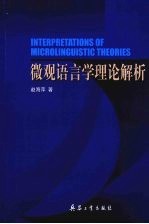图书介绍
微观语言学理论解析PDF|Epub|txt|kindle电子书版本网盘下载

- 赵海萍著 著
- 出版社: 北京:兵器工业出版社
- ISBN:9787802483446
- 出版时间:2009
- 标注页数:206页
- 文件大小:7MB
- 文件页数:218页
- 主题词:语言学-高等学校-教材-英文
PDF下载
下载说明
微观语言学理论解析PDF格式电子书版下载
下载的文件为RAR压缩包。需要使用解压软件进行解压得到PDF格式图书。建议使用BT下载工具Free Download Manager进行下载,简称FDM(免费,没有广告,支持多平台)。本站资源全部打包为BT种子。所以需要使用专业的BT下载软件进行下载。如BitComet qBittorrent uTorrent等BT下载工具。迅雷目前由于本站不是热门资源。不推荐使用!后期资源热门了。安装了迅雷也可以迅雷进行下载!
(文件页数 要大于 标注页数,上中下等多册电子书除外)
注意:本站所有压缩包均有解压码: 点击下载压缩包解压工具
图书目录
Chapter 1 From Language to Linguistics1
1.1 Definition of language1
1.2 Origin of language3
1.2.1 The divine origin theory4
1.2.2 The inner spirit theory5
1.2.3 The nature theory6
1.2.4 The Sing-song theory7
1.3 The natures of language7
1.3.1 Displacement8
1.3.2 Arbitrariness8
1.3.3 Duality9
1.3.4 Productivity or creativity10
1.3.5 Cultural transmission11
1.3.6 Structure-dependence12
1.4 Functions of language13
1.4.1 Informative or ideational function13
1.4.2 Interpersonal function14
1.4.3 Performative function15
1.4.4 Emotive function15
1.4.5 Phatic communication16
1.4.6 Evocative function17
1.4.7 Recreational function17
1.4.8 Metalingual function17
1.5 From language to linguistics18
1.5.1 Linguistic knowledge19
1.5.2 Modern linguistics and traditional grammar19
1.5.3 The scope of linguistics20
1.6 Important distinctions in microlinguistics25
1.6.1 Synchronic vs.diachronic studies25
1.6.2 Speech vs.writing26
1.6.3 Descriptive approach vs.prescriptive approaches27
1.6.4 Langue vs.parole28
1.6.5 Competence vs.performance29
1.6.6 Macrolinguistics vs.microlinguistics29
1.7 Summary30
Exercises31
Chapter 2 From Phonetics to Phonology2.1 Phonetics38
2.1.1 Articulatory phonetics38
2.1.2 Acoustic phonetics39
2.1.3 Auditory phonetics40
2.2 Speech organs40
2.2.1 The initiator of the air stream41
2.2.2 Vocal cords41
2.2.3 Resonating cavities41
2.3 Segments and phonetic transcription47
2.3.1 Segments47
2.3.2 IPA and phonetic transcription47
2.4 Consonants50
2.4.1 Consonants and vowels50
2.4.2 Manners of articulation51
2.4.3 Places of articulation52
2.4.4 The consonants of English52
2.5 Vowels54
2.5.1 The criteria of vowel description54
2.5.2 The theory of cardinal vowels55
2.6 Coarticulation and phonetic transcription56
2.7 Broad and narrow transcriptions57
2.8 From phonetics to phonology58
2.9 Phonemes and allophones58
2.9.1 The phoneme theory58
2.9.2 Allophones60
2.10 Phonological processes62
2.10.1 Sequential rules62
2.10.2 Assimilation63
2.10.3 Deletion rule65
2.10.4 Devoicing65
2.11 Distinctive features66
2.12 Suprasegmental features67
2.12.1 Syllables67
2.12.2 Stress67
2.12.3 Intonation69
2.12.4 Tone70
2.13 Summary70
Exercises71
Chapter 3 Morphology:the Words of Language3.1 Introduction79
3.2 Content words and functional words80
3.3 Morpheme:the minimal units of meaning80
3.3.1 The individual morpheme81
3.3.2 Rules that combine morphemes84
3.4 Summary87
Exercises90
Chapter 4 Syntax:Sentence Structures90
4.1 The traditional approach101
4.1.1 Number,gender and case101
4.1.2 Tense,aspect and voice102
4.1.3 Concord and government103
4.1.4 Types of sentence104
4.2 The structural approach105
4.2.1 Signifier and signified108
4.2.2 Syntagmatic and paradigmatic relations109
4.2.3 Immediate constituent analysis(IC analysis)110
4.2.4 Endocentric and exocentric constructions111
4.3 The generative approach112
4.3.1 Deep and surface structures113
4.3.2 The trace theory114
4.3.3 Government,binding,etc115
4.4 The functional approach116
4.4.1 Functional sentence perspective118
4.4.2 Systemic-functional grammar119
4.5 Summary123
Exercises123
Chapter 5 Semantics:the Meaning of Language5.1 Introductions to semantics130
5.2 Some views concerning the study of meaning131
5.2.1 The Naming Theory131
5.2.2 Conceptualism(Mentalism)132
5.2.3 Contextualism133
5.2.4 Behaviorism134
5.3 Lexical semantics135
5.3.1 Reference and sense135
5.3.2 Utterance,sentence,proposition and propositional content136
5.3.3 Some well-known word relations137
5.4 Sense relations between sentences142
5.4.1 X is synonymous with Y143
5.4.2 X is inconsistent with Y143
5.4.3 X entails Y143
5.4.4 X presupposes Y.(Y is prerequisite of X)144
5.4.5 X is a contradiction144
5.5 Analysis of meaning144
5.5.1 Componential analysis—a way to analyze lexical meaning144
5.5.2 Predication analysis—a way to analyze sentence meaning145
5.6 Summary149
Exercises150
Chapter 6 Pragmatics:the Language in Use6.1 Introductions157
6.2 Context and meaning:deixis as an example159
6.2.1 Spatial deixis161
6.2.2 Temporal deixis162
6.2.3 Discourse deixis162
6.2.4 Person deixis162
6.2.5 Social deixis162
6.3 Speech Acts163
6.3.1 Austin's model of Speech Acts163
6.3.2 Searle's classification of Speech Acts165
6.4 The Cooperative Principle168
6.5 Implicature170
6.6 Other interests of pragmatics171
6.7 Summary173
Exercises175
Index:A glossary of some linguistic terms180
References204